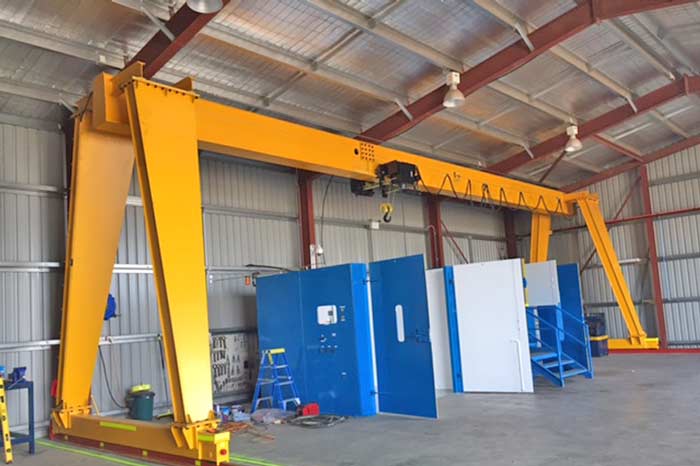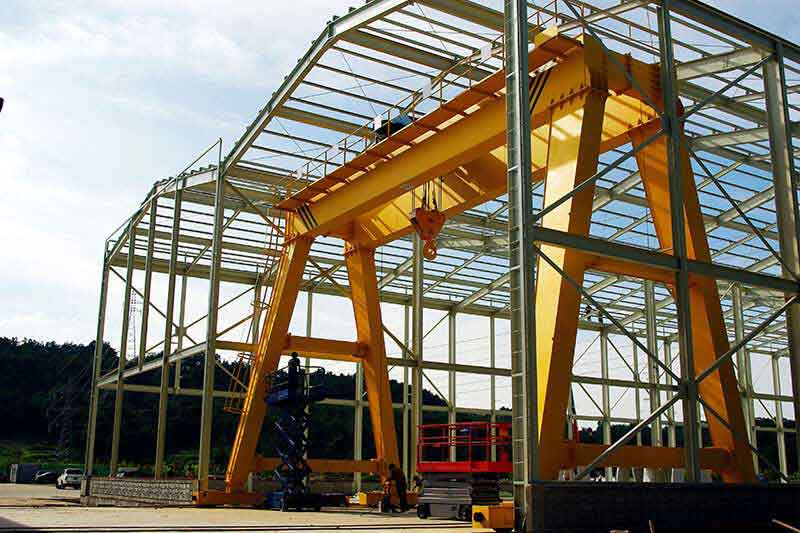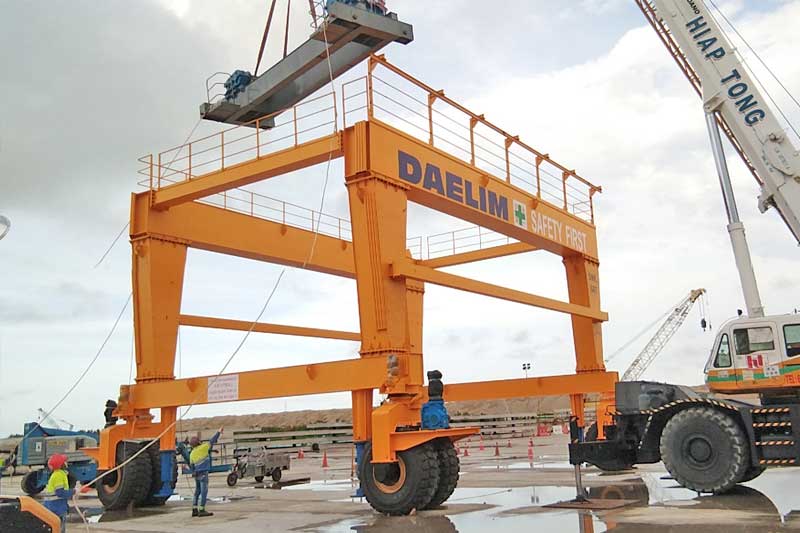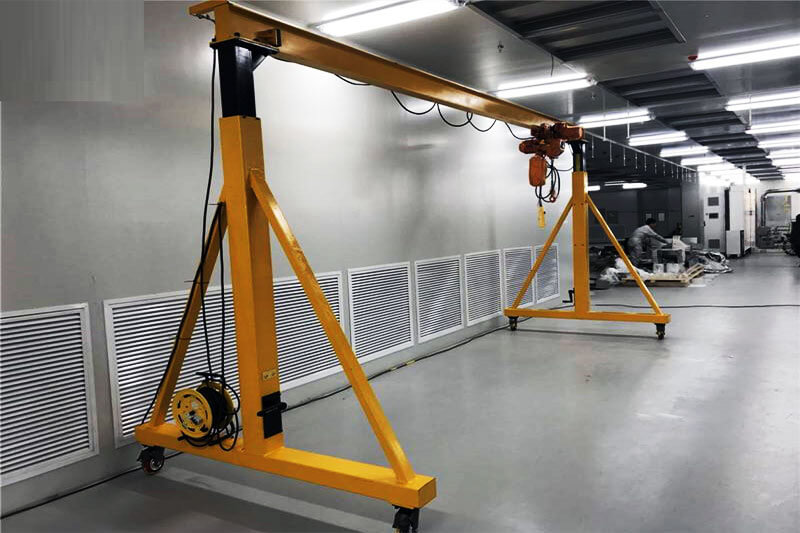Gantry Crane for Material handling in Wheel Manufacturing in USA
Gantry Crane for sale USA 5 ton to 40 ton for general material handling in wheel processing industrial sectors. All types gantries, custom design , good price.
Gantry cranes have emerged as indispensable assets within the landscape of U.S. wheel manufacturing, playing a pivotal role in the seamless execution of various production processes. The symbiotic relationship between gantry cranes and wheel manufacturing is rooted in the dual pillars of precision and adaptability. In this exploration, we delve into the core significance of gantry cranes, unveiling how their precision and adaptability elevate the efficiency and efficacy of U.S. wheel manufacturing.
Gantry cranes stand as stalwart companions in the intricate dance of wheel production. Their towering presence and mechanical prowess facilitate the movement and manipulation of heavy loads, orchestrating the manufacturing symphony with finesse. From the raw materials' arrival to the final assembly of wheels, gantry cranes navigate the intricate web of production, ensuring a streamlined and efficient workflow.
Precision and adaptability emerge as linchpins in the functionality of gantry cranes within the wheel manufacturing domain. The precision with which these cranes operate ensures that every movement is calculated, contributing to the overall accuracy of the manufacturing process. Simultaneously, their adaptability allows them to navigate the dynamic challenges posed by the diverse components and evolving requirements of wheel production. As we unravel the layers of these crucial attributes, we gain insights into the transformative impact they exert on the U.S. wheel manufacturing landscape.
- Description: Single girder gantry cranes consist of a single horizontal beam supported by vertical legs at both ends. They are suitable for light to moderate wheel handling applications.
- Use Case: Single girder gantry cranes are often used in facilities where the weight of the wheels is within the crane's capacity range, and cost-effective solutions are preferred.

- Description: Double girder gantry cranes feature two horizontal beams (girders) supported by vertical legs. This design provides increased stability and lifting capacity compared to single girder cranes.
- Use Case: Double girder gantry cranes are employed in situations where heavier wheel components need to be lifted and moved with precision. They offer higher load capacities and are suitable for large manufacturing facilities.

Rubber-Tired Gantry Crane (RTG):
- Description: RTG cranes are mounted on rubber tires, allowing them to move horizontally along the ground. They are versatile and can be used both indoors and outdoors.
- Use Case: RTG cranes are often employed in wheel manufacturing yards or facilities with variable layouts. Their mobility makes them suitable for handling wheels in different locations within the manufacturing site.
Rail-Mounted Gantry Crane (RMG):
- Description: RMG cranes are fixed to a set of rails, providing a stable and linear path for movement. They are commonly used in manufacturing facilities with well-defined and linear layouts.
- Use Case: RMG cranes are suitable for handling wheels along a specific path, such as along an assembly line or a dedicated production route. They offer precision and efficiency in linear handling processes.

- Description: Portable gantry cranes are lightweight and can be easily moved to different locations within a facility. They typically have wheels for mobility.
- Use Case: Portable gantry cranes are ideal for smaller manufacturing setups or workshops where the crane needs to be repositioned frequently to handle wheels at different workstations.
The selection of the appropriate gantry crane type depends on the specific requirements and constraints of the wheel manufacturing process. It's crucial to consider factors such as load capacity, mobility, and the layout of the manufacturing facility to choose the most suitable gantry crane for wheel handling applications.
Gantry cranes in U.S. wheel manufacturing showcase a diverse array of capacities, underscoring their adaptability to varied production needs. The lower threshold of this spectrum sees cranes with a minimum capacity of 5 tons, apt for handling lighter loads and facilitating intricate maneuvers within the manufacturing space. On the other end, the robust giants emerge with a commanding maximum capacity of 40 tons, flexing their mechanical muscles to effortlessly hoist heavier components essential in the wheel production process.
The significance of these versatile tonnages lies in their ability to cater to the dynamic demands of wheel manufacturing. Different stages of the production process entail the handling of diverse loads, from raw materials to semi-finished products and final assemblies. The adaptability in tonnages ensures that gantry cranes seamlessly transition between these tasks, optimizing efficiency and resource utilization. In the intricate dance of wheel production, where each component carries a unique weight, the ability of gantry cranes to flexibly manage varying tonnages emerges as a strategic advantage, underscoring their indispensable role in the manufacturing ecosystem.
Typical Loads Handling
As we journey further into the heart of U.S. wheel manufacturing, the spotlight turns towards the intrinsic link between gantry cranes and the myriad components that populate the manufacturing workshops. Understanding the typical loads handled by these mechanical behemoths provides a glimpse into their multifaceted role within the intricate tapestry of wheel production.
Wheel manufacturing workshops are bustling hubs of activity, housing a diverse array of components crucial to the production process. From raw materials in their nascent form to semi-finished products awaiting refinement, and finally, the gleaming finished products ready for distribution, these workshops are dynamic landscapes requiring precision and adaptability.
Specific Examples of Loads Handled by Gantry Cranes
- Raw Materials: Gantry cranes shoulder the responsibility of transporting raw materials to the heart of the manufacturing process. Whether it be steel, aluminum, or other essential components, these cranes deftly navigate the workshop, depositing the building blocks necessary for crafting quality wheels.
- Semi-finished Products: In the intermediary stages of wheel production, gantry cranes take center stage in handling semi-finished products. These could range from partially assembled wheel components to materials undergoing specific treatments. The cranes' precision becomes paramount as they delicately manipulate these semi-finished products, setting the stage for the final phases of production.
- Finished Products: The culmination of the manufacturing journey sees gantry cranes gracefully lifting and transporting finished wheels. Their adaptability ensures a smooth transition from the production line to storage or distribution areas. The ability to handle the completed products with finesse showcases the all-encompassing role gantry cranes play in the lifecycle of U.S. wheel manufacturing.
In orchestrating the intricate dance of loads within wheel manufacturing workshops, gantry cranes emerge as the choreographers, seamlessly guiding each component through its designated steps with the precision and adaptability demanded by the industry.
Precision in Gantry Cranes
Precision stands as a cornerstone in the symphony of wheel manufacturing processes, and gantry cranes take center stage as virtuosos conducting this orchestration. In this segment, we delve into the paramount importance of precision in wheel manufacturing and explore the sophisticated features embedded within gantry cranes that elevate them to the role of meticulous conductors in this industrial symphony.
Wheel manufacturing is a process where millimeters matter, and tolerances are tight. Precision is not merely a desirable attribute but an absolute necessity to ensure the quality, safety, and functionality of the final product. In this context, the role of gantry cranes as precision instruments becomes crucial. Their ability to execute movements with pinpoint accuracy directly influences the overall quality of wheel manufacturing processes.
Features of Gantry Cranes that Contribute to Precision
Advanced Control Systems: Gantry cranes are equipped with state-of-the-art control systems that go beyond basic functionalities. These advanced systems allow for intricate programming, enabling operators to fine-tune movements with precision. Whether it's lifting, lowering, or traversing, the cranes respond to nuanced commands, ensuring that each operation is executed with the exactitude demanded by the wheel manufacturing environment.
High-Tech Sensors: At the heart of gantry crane precision lies the integration of high-tech sensors. These sensors serve as the eyes and ears of the crane, providing real-time data on load positions, environmental conditions, and equipment status. With this wealth of information, gantry cranes make split-second adjustments, adapting to changing variables and maintaining the meticulous precision required throughout the manufacturing process.
The marriage of advanced control systems and high-tech sensors transforms gantry cranes into precision tools finely tuned for the intricate ballet of wheel production. As they navigate the workshop, these cranes exemplify how technological prowess enhances the precision of industrial processes, leaving an indelible mark on the quality and reliability of U.S. wheel manufacturing.
Adaptability in Gantry Cranes
Adaptability emerges as the dynamic force propelling gantry cranes to the forefront of innovation in U.S. wheel manufacturing. In this segment, we explore the challenges inherent in wheel manufacturing that demand a high degree of adaptability from gantry cranes. Additionally, we unravel the key characteristics that endow these mechanical marvels with the flexibility to seamlessly navigate the ever-changing landscape of wheel production.
Challenges in Wheel Manufacturing that Require Adaptable Cranes
Wheel manufacturing is a realm rife with challenges, from the diverse sizes and shapes of components to the evolving production requirements dictated by market trends. Adaptable cranes become indispensable in overcoming these challenges, addressing the dynamic nature of the industry. Challenges such as frequent changes in load specifications, varying production volumes, and the need for rapid reconfiguration demand gantry cranes that can adeptly pivot to meet these demands.
Characteristics that Make Gantry Cranes Adaptable
Adjustable Configurations:
Gantry cranes designed for U.S. wheel manufacturing boast adjustable configurations that allow them to morph according to the specific needs of the production environment. Whether it's altering the span, height, or outreach, these cranes exhibit a chameleon-like ability to adapt to the changing dimensions of the workspace. This feature ensures that they can seamlessly traverse different sections of the manufacturing facility, accommodating varied load sizes and layouts.
Customizable Features:
The adaptability of gantry cranes is further amplified by their customizable features. Manufacturers have the flexibility to tailor the cranes to their unique requirements, incorporating specialized attachments or modifications. This bespoke approach empowers wheel manufacturing facilities to optimize their gantry cranes for specific tasks, ensuring that the equipment is not just a passive component but an active, adaptable partner in the manufacturing journey.
In the fluid landscape of U.S. wheel manufacturing, where change is the only constant, gantry cranes equipped with adaptability become strategic allies. Their ability to confront and conquer challenges, coupled with adjustable configurations and customizable features, positions them as agile contributors to the success of wheel production processes.
Future Trends
As we cast our gaze towards the horizon of innovation, the future of gantry cranes in U.S. wheel manufacturing beckons with promises of even greater precision and adaptability. In this section, we explore the emerging technologies in gantry crane manufacturing and anticipate the developments that will shape their role in the dynamic landscape of U.S. wheel production.
Emerging Technologies in Gantry Crane Manufacturing
Automation and Artificial Intelligence:
The integration of automation and artificial intelligence (AI) is set to redefine the capabilities of gantry cranes. Smart cranes equipped with AI algorithms can analyze data in real-time, optimizing movements and anticipating production needs. This leap in technology promises not only increased precision but also the ability to proactively adapt to changing conditions within the manufacturing environment.
IoT Connectivity:
The Internet of Things (IoT) is poised to revolutionize gantry crane operations. By connecting cranes to a network of sensors and devices, manufacturers can gather comprehensive data on crane performance, enabling predictive maintenance and enhancing overall reliability. This connectivity also facilitates remote monitoring and control, providing unprecedented flexibility in managing gantry cranes across different manufacturing facilities.
Anticipated Developments in the Use of Gantry Cranes in U.S. Wheel Manufacturing
Enhanced Customization Features:
The trend towards customization is expected to intensify, prompting manufacturers to demand gantry cranes with even more sophisticated customization features. This could include modular attachments that can be easily swapped, allowing for rapid adaptation to new wheel designs and production requirements.
Eco-Friendly Innovations:
With an increased focus on sustainability, the future of gantry cranes in U.S. wheel manufacturing may witness the integration of eco-friendly technologies. This could involve the use of energy-efficient components, regenerative braking systems, and other innovations aimed at reducing the environmental impact of crane operations.
Collaborative Robotics:
The synergy between gantry cranes and collaborative robotics is likely to grow. Collaborative robots working alongside gantry cranes can further enhance the adaptability of manufacturing processes. These robots can handle intricate tasks while gantry cranes focus on heavy lifting, creating a harmonious and efficient production ecosystem.
As U.S. wheel manufacturing continues to evolve, the trajectory of gantry cranes points towards a future where cutting-edge technologies converge to redefine the benchmarks of precision, adaptability, and sustainability. The synergy between human ingenuity and technological innovation is poised to elevate gantry cranes to new heights, ensuring they remain indispensable contributors to the success of the wheel manufacturing industry.
Conclusion
In the intricate dance of U.S. wheel manufacturing, the symbiotic relationship between versatile gantry cranes, precision, and adaptability emerges as the linchpin to success. As we conclude this exploration, it is paramount to recapitulate the key points that underscore the pivotal role these mechanical marvels play in shaping the landscape of wheel production.
- Gantry Crane Capacity: The diverse range of capacities, from 5 tons to 40 tons, highlights the adaptability of gantry cranes to handle a spectrum of loads within the wheel manufacturing process.
- Typical Loads Handling: Gantry cranes navigate the dynamic landscape of wheel manufacturing workshops, deftly handling raw materials, semi-finished products, and finished products with precision.
- Precision in Gantry Cranes: Precision stands as a non-negotiable attribute in wheel manufacturing, and gantry cranes equipped with advanced control systems and high-tech sensors exemplify the pinnacle of precision engineering.
- Adaptability in Gantry Cranes: Challenges in wheel manufacturing find their match in adaptable gantry cranes, boasting adjustable configurations and customizable features that enable them to seamlessly navigate the evolving demands of the industry.
- Case Studies: Real-world examples from U.S. wheel manufacturing facilities underscore how the marriage of precision and adaptability in gantry cranes translates into tangible success stories.
Affirmation of the Crucial Role of Versatile Gantry Cranes
In essence, gantry cranes stand as the unsung heroes of U.S. wheel manufacturing, orchestrating a harmonious production symphony where precision and adaptability dance in unison. Their towering presence and technological prowess not only meet the challenges of today but also pave the way for a future where innovation and efficiency reign supreme.
As wheel manufacturing continues to evolve, one truth remains constant: the versatility of gantry cranes is not just a convenience but a strategic imperative. Their ability to lift, move, and adapt with unparalleled precision positions them as indispensable partners in the journey towards crafting wheels that not only roll but set the wheels of progress in motion.




